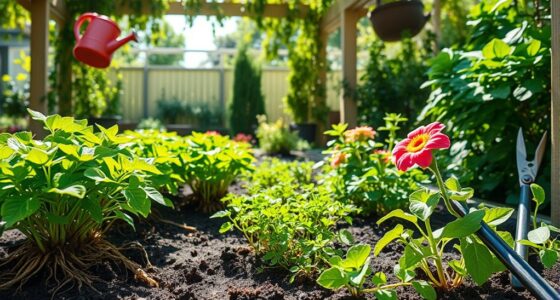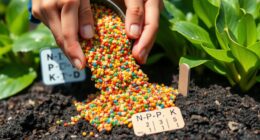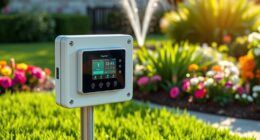To avoid common gardening mistakes, guarantee you plant each species in the right light conditions—shade-loving plants in shady spots and sun lovers in sunny areas. Don’t overwater; check soil moisture first and use tools like self-watering pots for consistency. Pay attention to your plants’ specific needs for water and light, as missteps can cause stress, disease, or poor growth. If you want your garden to flourish, understanding these basics is key—keep exploring how to do it right.
Key Takeaways
- Research each plant’s light requirements to avoid improper placement and ensure healthy growth.
- Check soil moisture before watering to prevent overwatering and root rot.
- Match plant choices with garden spots suited to their specific light and water needs.
- Avoid forcing shade-loving plants into sunny areas or sun-loving plants into shady spots.
- Use tools like self-watering pots to maintain consistent moisture and promote plant health.

Have you ever wondered why your garden isn’t thriving despite your efforts? Many beginners face common mistakes that hold back their plants’ growth and health. One frequent issue is trying to grow plants in areas that don’t suit their needs, especially when it comes to planting in shade. Not all plants thrive in low-light conditions, so understanding which plants prefer shade is vital. If you plant sun-loving species in shady spots, they’ll struggle, become leggy, or fail to produce flowers or fruits. Conversely, trying to force shade-loving plants into bright, exposed areas can lead to scorched leaves and weak growth. Before planting, research the specific light requirements of each plant and choose spots in your garden accordingly. This simple step prevents disappointment and guarantees your plants have the best chance to flourish.
Another mistake many beginners make is overwatering plants. It might seem like giving more water helps them grow faster, but this often causes more harm than good. Overwatering can lead to root rot, fungal diseases, and weak, unhealthy plants. Recognizing when your plants need water is key. Instead of sticking to a fixed schedule, check the soil moisture first—stick your finger about an inch into the soil. If it feels moist, hold off watering. If it’s dry, then give your plants a drink. Proper watering practices encourage healthy root development and prevent waterlogging, which can drown roots and lead to other issues. Remember, different plants have different water needs, so tailor your watering habits accordingly. For example, succulents and cacti require less frequent watering compared to leafy greens or annual flowers. Using self watering plant pots can help maintain consistent moisture levels and prevent overwatering.
Frequently Asked Questions
How Often Should I Water My New Plants?
For your new plants, establishing a consistent watering schedule is key to proper plant hydration. Water them deeply once or twice a week, depending on the type of plant and weather conditions. Always check the soil moisture before watering—if it feels dry a few inches down, it’s time to water. Avoid overwatering, which can cause root rot. Adjust your watering routine as your plants grow and seasons change for ideal health.
What Is the Best Soil Type for Beginners?
Starting with the right soil is like laying a solid foundation. As a beginner, you should look for a well-draining soil mixture that balances nutrients and moisture. Adding organic amendments like compost boosts fertility and improves soil structure. Stick to a loamy soil, which is easy to work with and provides good aeration. This approach helps your plants thrive, making gardening enjoyable and less of a shot in the dark.
How Do I Prevent Pests Without Chemicals?
To prevent pests naturally, start by planting native plants that attract beneficial insects and repel pests. Practice companion planting by pairing crops that support each other’s health and deter unwanted visitors. Keep your garden healthy with proper watering and soil care, which makes plants less vulnerable. Regularly inspect your plants and remove pests manually. These strategies create a balanced ecosystem, reducing the need for chemical interventions and keeping your garden thriving.
When Is the Ideal Time to Prune?
Did you know that proper pruning timing can boost plant growth by up to 30%? The best time for seasonal trimming varies, but generally, you should prune in late winter or early spring before new growth starts. For flowering plants, wait until after blooms fade. Pruning at the right moment encourages healthy growth, prevents disease, and keeps your garden looking its best. Always research your specific plants for ideal pruning times.
How Can I Start Composting at Home?
To start composting at home, first choose a suitable compost bin and place it in a well-drained, shaded spot, away from direct sunlight. Keep an eye on the composting temperature, aiming for 130-160°F to speed up decomposition and kill weeds or pathogens. Add a mix of green and brown materials, turning the pile regularly to maintain airflow. Stay patient—your rich compost will be ready in a few months.
Conclusion
Avoiding these common gardening mistakes can make a big difference in your success. Did you know that over 70% of beginner gardeners see improved results just by planning better and understanding their plants’ needs? By steering clear of issues like overwatering or neglecting soil health, you’ll enjoy a lush, thriving garden. Keep learning, stay patient, and watch your green thumb grow—your garden’s future is brighter with a few simple tips!









